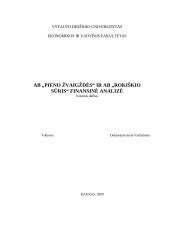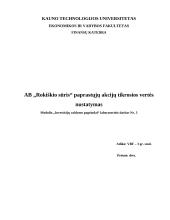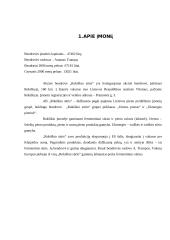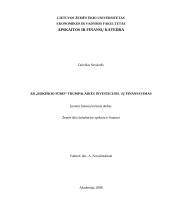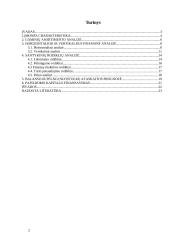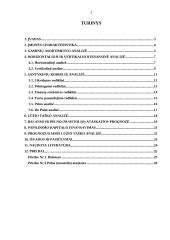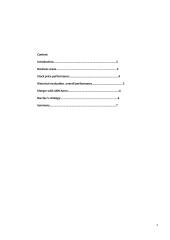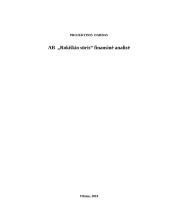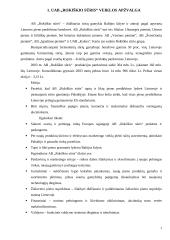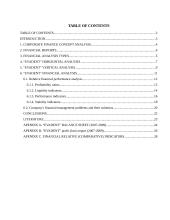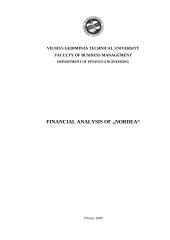Referatai
Financial statement analysis: AB "Rokiškio sūris"
FINANCIAL STATEMENT ANALYSIS OF ‘ROKIŠKIO SŪRIS’ AB The assignment CONTENTS INTRODUCTION 3 1. THE INTRODUCTION OF ‘ROKIŠKIO SŪRIS‘ AB 4 2. THE ANALYSIS OF PROFITABILITY, LIQUIDITY AND STABILITY RATIOS 5 3. THE COMPARISON OF CALCULATED RATIOS WITH THE LEVEL OF INDUSTRY AVERAGE 11 4. CONCLUSIONS 12 5. REFERENCES 13 6. APPENDIXES 14 INTRODUCTION Financial statement analysis is very important for every company in order to assess the liquidity, profitability and stability of a business. Such kinds of reports must be presented to top managers for making very important business decisions. For this reason such kind of these analysis are prepared all the time and the information which is provided is essential. According to the importance of financial statement analysis, in this paper work it is analyzed one Lithuanian company – ‘Rokiškio sūris’ AB. After the analysis it will possible to state what is real situation of the company, especially to look how the situation has changed after business recession. The target goal of the assignment – to make the analysis of company’s financial statement, to count main profitability, liquidity and stability ratios and compare with the level of industry average. The objectives are: 1. to calculate main profitability, liquidity and stability ratios for ‘Rokiškio sūris’ AB; 2. to make horizontal and vertical analysis of financial statements; 3. to compare calculated ratios with the level of industry average. Sources: scientific literature, Department of Statistics to the Government of the Republic of Lithuania, and other (e.g. Google, second sources). 1. THE INTRODUCTION OF ‘ROKIŠKIO SŪRIS‘ AB ‘Rokiškio sūris’ AB, often called the flagship of Lithuanian dairy industry, is an excellent example of how traditions can go hand in hand with a modern manufacturing process. It is not accidental that this company is located in Aukstaitija, one of the most beautiful regions of Lithuania, where fertile plains and luxuriant meadows are surrounded by forests and decorated with blue lakes, where the land itself has been famous for dairying traditions and the largest milk yields for centuries. Favourable geographical location ensures good communication with the largest cities, especially with Klaipeda seaport, which is the point of export of the company's production to the Western markets. There is a convenient railway connection with Moscow and St. Petersburg.1 ‘Rokiškio sūris’ AB is joint stock company, which main activities are these: dairy activities and cheese production. The company provides its production for the domestic market and exports to European Union and Russian markets. It is needed to mention that the main competitor of the company is ‘Pieno žvaigždės’ AB, which also produces similar products. The mission of the company – ‘Rokiškio sūris’ is a strong, modern and reliable enterprise which is creating and constantly increasing its value for company participants as well as taking care of the welfare of its staff. The vision of the company is to become the leader of in milk processing in Lithuania and the leader in cheese making in the Baltic States. Financial statements of the company are prepared in accordance with International Financial Reporting Standards. 2. THE ANALYSIS OF PROFITABILITY, LIQUIDITY AND STABILITY RATIOS Financial ratios quantify many aspects of a business and are an integral part of financial statement analysis. Financial ratios allow for comparisons between companies, industries, different time periods for one company, a single company and its industry average. For this reason, it is going to be calculated some of them the most important. Profitability ratios: Figure 1 Net profit margin shows how much profit ‘Rokiškio sūris‘ AB gets for every 1 LTL of total sales. So it is possible to see from Figure 1 that in 2008 the company became not so much effectively at cost control. The highest profit margin was in 2007, so more effective ‘Rokiškio sūris‘ was converting revenue into actual profit. To sum up, it is clear that this ratio indicates profit levels of a business after all costs have been taken into account. But it is needed to suggest for the company, even if it meets its goal, it should always still keep an eye on its profit margin. From 2007 it started to decline, so the company must take a look at whether its costs are getting too high. Figure 2 Net Return on Assets is a useful way to measure how well the company is actually able to make intelligent choices on how to spend its money on new assets. As we can see from Figure 2, the highest ROA number was in 2007 (10.43%) and it shows that the company was earning more money on less investment. Unfortunately, in 2008 ‘Rokiškio sūris‘had a net income of 18.729 LTL in thousands and total average assets of 346.745 LTL in thousands, what brought negative -5.40% net ROA (Appendixes 1, 2). It is the evidence, that in 2008 when company earned approximately three times less income with almost the same total average assets, it had tripled negative ROA. Based on this numbers, ‘Rokiškio sūris‘ was the best at converting its investment into profit in 2007. We can make conclusion, that the lower the profit per LTL of assets, the more asset-intensive a business is. For this reason, more money must be reinvested into it to continue generating earnings. And this is real bad thing for the company, because if in 2008 a ROA was -5.40%, it means that it lost -0.054 LTL for each 1 LTL in assets. Figure 3 One of the most important profitability metrics is Return on Equity I, because it shows how much profit the ‘Rokiškio sūris‘ earned in comparison to the total amount of shareholders average equity. As we can see from Figure 3, the lowest ROE was in 2008, and it shows that the company becomes less capable to generate cash internally. As we can see that the mission of every company is to earn a higher ROE as possible, and ‘Rokiškio sūris‘ does not do progress, because more profit it generates on the money shareholders have invested in the company. Liquidity ratios: Liquidity ratios provide information about the company's ability to meet its short-term financial obligations. The Current Ratio is one of best ratio to measure the financial strength of a firm. Figure 4 From Figure 4 it is possible to say that generally the figures are acceptable, because the Current Ratio is more than 1 during all last three years. So the company has enough current assets to meet the payment schedule of its current debts with a margin of safety for possible losses in current assets.2 Moreover, it is needed to add that short-term creditors prefer a high current ratio since it reduces their risk. But shareholders may prefer a lower current ratio so that more of the firm's assets are working to grow the business. As we can see the company holds the position in the middle. The second ratio for valuating company’s liquidity is Quick ratio. The proportion of figures is very similar to Figure 4, where the company with steadily rising inventories looks good with the Current Ratio, but has a deteriorating effect on the Quick Ratio, when inventories here are ignored. Figure 5 shows that ‘Rokiškio sūris‘ is not so much strong to convert its current assets into cash which are not enough sufficient to cover current liabilities. Because during all analyzed years, the ratio was lower than 1. For this reason, the company’s quick assets are not enough highly liquid. Figure 5 Finally, Debt to Equity Ratio can also show how would be if for example the company went to bankrupt, the creditors would be paid before the stockholders. Figure 6 This ratio also confirms that 2007 was the best year for the company during analyzed three years. Especially in 2008 the amount of Total liabilities increased to 186.469 LTL in thousands (Appendix 1, Figure 1) and it means that the more risky this company becomes, because the amount of total liabilities in this year was the highest. So if ‘Rokiškio sūris‘ went bankrupt, the creditors would be paid before the stockholders. Moreover, in 2008 the situation a little bit has changed, because less equity the stockholders provided (from 193.033 LTL in thousands in 2006 to 173.077 LTL in thousands in 2008, Appendix 1, Figure 1) and it means that less protected creditors are and less attractive the financial position of ‘Rokiškio sūris‘ becomes. Stability ratios: Talking about the stability of ‘Rokiškio sūris‘, it is needed to calculate additional ratios, such as Fixed Asset Turnover when we talk about long-term financial stability of the company. Figure 7 Figure 7 shows that the situation from 2006 a little bit has changed to better side, because the ratio increased from 4.15 to 5.64. It means that ‘Rokiškio sūris‘ started better to use its fixed assets to generate sales. In 2006 the company was worse in utilizing its plant and equipment. In 2007-2008 higher turnover value shows that the company does not have so much heavy investments in long-term capital assets. Figure 8 Debt ratio is very informative, when we want to know how many percents of ‘Rokiškio sūris‘ assets are financed with debt. From Figure 8 it is possible to see that company’s total assets are in effect controlled by external parts. From 2006 and 2008 the business was no so much geared. Figure 9 Lastly, the third ratio for stability evaluation was calculated Equity Ratio, which shows how many percents of total assets are provided by the owners of the company. In 2007 from Figure 9 it is possible to see, that ‘Rokiškio sūris‘ was the most stable and less risky, because in 2007 Equity ratio amounted 22.47%. From 2007 the ratio started to decline and it means that the company has to restrain further increases in debt. Moreover, the comparison of each rate with the whole, the vertical and horizontal analysis were done. Vertical assets analyze shows that ‘Rokiškio sūris‘ non-current assets from 2006 to 2008 decreased about 4%, because the company has sold some tangible assets. Declining tangible assets comparative size shows that the company reduces tangible assets elements, which are important to develop its activity (Figure 19). Figure 10 Meanwhile, the horizontal analysis shows the dynamics of rates in absolute numbers and percentages. From horizontal analysis it is possible to say that the amount of total assets increased: from 2006 to 2007 the amount of total assets increased 4.58%, from 2207 to 2008 – 13.8%. The amount of total equity and liabilities also increased, in 2006-2007 period by 3.47%, in 2007-2008 by 7.67%. 3. THE COMPARISON OF CALCULATED RATIOS WITH THE LEVEL OF INDUSTRY AVERAGE Comparing the main ratios of ‘Rokiškio sūris‘ with industry average, was selected just 2008 year, because the suitable information for previous year is not provided in Department of Statistics to the Government of the Republic of Lithuania website. According to Appendix 8, it is possible to see that the company is worse than enterprises of manufacture of food products and beverages in the main profitability ratios. First of all, the Gross Profit Margin is lower even 0.6 times and Pretax Profit Margin is even one time lower than the average of the industry. Figure 11 When we analyze ratios more related to liquidity, it is clear that the company’s situation is almost the same or even better than other enterprises in the industry (Figure 11). For example, Current Assets to Equity ratio exceeds the average of the industry 0.28 time. 4. CONCLUSIONS 1. After the analysis of three profitability ratios during 2006-2008 period, it is possible to say that the company’s profitability highly decreased in 2008. During 2006-2007 ‘Rokio sūris‘ was profitable. 2. According to Curent Ratio, the company is liquide and can meet its obligations. 3. Some ratios, such as Quick Ratio confirms the company sometimes is in dangerous situation, because not all the time it has enough money to pay its liabilities. 4. After the comparison of company’s main profitability and liquidity ratios with enterprises of manufacture of food products and beverages, it is possible to say that the company must strengthen itself in profitability area. Main ratios related to liquidity are almost the same or even exceeds the average of the industry. 5. REFERENCES 1. Department of Statistics to the Government of the Republic of Lithuania website
Šį darbą sudaro 2081 žodžiai, tikrai rasi tai, ko ieškai!
★ Klientai rekomenduoja
Šį rašto darbą rekomenduoja mūsų klientai. Ką tai reiškia?
Mūsų svetainėje pateikiama dešimtys tūkstančių skirtingų rašto darbų, kuriuos įkėlė daugybė moksleivių ir studentų su skirtingais gabumais. Būtent šis rašto darbas yra patikrintas specialistų ir rekomenduojamas kitų klientų, kurie po atsisiuntimo įvertino šį mokslo darbą teigiamai. Todėl galite būti tikri, kad šis pasirinkimas geriausias!
Norint atsisiųsti šį darbą spausk ☞ Peržiūrėti darbą mygtuką!
- Finansų referatas
- 20 psl., (2081 ž.)
- Word failas 495 KB
- Lygis: Universitetinis
Mūsų mokslo darbų bazėje yra daugybė įvairių mokslo darbų, todėl tikrai atrasi sau tinkamą!
Panašūs darbai
Privalumai
Atsisiuntei rašto darbą ir neradai jame reikalingos informacijos? Pakeisime jį kitu nemokamai.
Pirkdamas daugiau nei vieną darbą, nuo sekančių darbų gausi 25% nuolaidą.
Išsirink norimus rašto darbus ir gauk juos akimirksniu po sėkmingo apmokėjimo!
Atsiliepimai


























